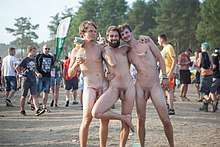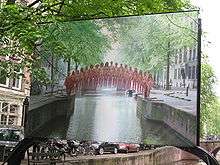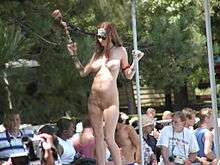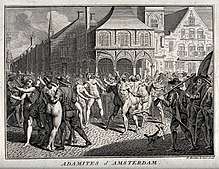Public nudity

Public nudity refers to nudity not in an entirely private context, that is, a person appearing nude in a public place or being able to be seen nude from a public place. Nudity on private property but where the general public is commonly free to enter, such as a shopping mall, public transport or swimming pool, is also considered public nudity. Nudity in the privacy of a person's home or grounds is not considered public nudity, nor is nudity at privately owned facilities where nudity commonly takes place, such as gymnasia, locker rooms, saunas, or specific nudist clubs or resorts. Naturism is a movement that promotes social nudity in nature, most but not all of which takes place on private property.
Western world
Social public nudity

Not all people who engage in public nude events see themselves as naturists or belong to traditional naturist or nudist organizations. Some activists, such as Vincent Bethell, claim that association with naturism or nudism is unnecessary. Others will point out that many people who participate in events such as clothing-optional bike rides or visit clothing-optional beaches do so casually and without association or formal affiliation to groups or movements. Activist Daniel Johnson believes that labels and affiliations overly complicate a relatively simple phenomenon, alienate others from a fear of over-commitment or undesirable stereotypes, and thus get in the way of integrating nudity into everyday life.
The social norms or laws of each culture require the wearing of clothes in most situations, but this expectation may be suspended in limited circumstances. For example, there are many countries which have designated public areas as nude beaches, or where nude bathing is unofficially tolerated. In those places, a person would not face legal prosecution or official harassment merely for being nude.
Outside of those areas, community and legal acceptance of public nudity varies considerably. To avoid offending the public in general, public authorities maintain what are sometimes called "standards of decency". What falls outside these standards are usually termed "indecent exposure", or similar terminology. These standards, however, vary with time and place. If the intent is to draw attention to oneself, it may be referred to as exhibitionism, otherwise it may be to draw attention to a cause (see nudity and protest). There are also some people who disrobe in public to attract publicity to themselves, as a career move, such as some streakers at sporting events. There are also others who spontaneously disrobe in public, as an expression of their freedom and the shedding of inhibitions; an example being skinny dipping.
Public social nude events

Some people take part in non-sexual public nude events. These may be in a naturist resort or club or at a nude beach. Outdoor nude recreation can take place in private or rural areas, though generally limited to warm weather.
Others practice casual public nudity. Topfree sunbathing is considered acceptable by many on the beaches of Finland, France, Spain, Italy and most of the rest of Europe (and even in some outdoor swimming pools); however, exposure of the genitals is restricted to nudist areas in most regions. In the United States, topfree sunbathing and wearing thongs are not common in many areas, but are limited to nude beaches in various locations. It is normally acceptable for men in the U.S. to be barechested or shirtless when engaged in outdoor recreational activities.
Where the social acceptability of nudity in certain places may be well understood, the legal position is often less clear cut. In England, for example, the law does not actually prohibit simple public nudity, but does forbid indecent exposure.[1] In practice, this means that successful prosecution hangs on whether there is a demonstrable intention to shock others, rather than simply a desire to be nude in a public place. Specifically, using nudity to "harass, alarm or distress" others is an offence against the Public Order Act of 1986. Occasional attempts to prove this point by walking naked around the country therefore often result in periods of arrest, followed by release without charge, and inconsistencies in the approach between different police jurisdictions. Differences in the law between England and Scotland appear to make the position harder for naked ramblers once they reach Scotland.
Photography of installations of massed nude people in public places, as made repeatedly around the world by Spencer Tunick, claim artistic merit.
Legal position

It is generally accepted in western countries that a naked human body is not in itself indecent. That principle is reflected, for example, in depiction of the human form in art of various forms.
The lack of appropriate clothing may cause offence to others, giving raise to legal intervention in the form of charges described, for example, as indecent, offensive or disorderly conduct. This is the position, for example, in Germany[2] and Spain, although local laws in the latter country can stipulate that public nudity is either restricted or not permitted. In Barcelona, public nudity used to be regarded as a recognised right, although there have been successful prosecutions for public nudity even there and a local ordinance by the local council in May 2011 empowers the authorities to impose a fine for nudity and being bare chested.[3] In the Netherlands, public nudity is allowed on sites that have been assigned by the local authorities and other suitable places which effectively means any complaint will cause one to be arrested as a complaint is indication that the place was not "suitable".[4]
In many countries public nudity is forbidden outright on the basis that nudity is inherently sexual. Many states of the United States fine offenders on that basis—see Indecent exposure in the United States.[5] In Arkansas, not only is nudism illegal (even on private property), it is a crime to "promote" or "advocate" (i.e. express a favorable opinion about) nudism.[6] In many contexts, public nudity has been more accepted, especially at designated areas such as nude beaches and, even in the United States, e.g. during World Naked Bike Ride events or Bay to Breakers. In some states, such as Oregon, public nudity is legal and protected as free speech, as long as there is not the "intent to arouse". In the United Kingdom, nudity per se is not unlawful, but the circumstances surrounding particular episodes of nudity may create public order offences, according to a police spokesman in July 2013.[7] After repeated arrest, prosecution, conviction in Great Britain, the activist Stephen Gough sued at the European Court of Human Rights for his right to be nude in public outside of designated areas (like nude hiking). Gough's case concerned only charges brought against him in Scotland. The ECHR rejected his complaint in October 2014,[8] stating that authorities in Scotland had not "unjustifiably interfered with his exercise of freedom of expression", though they did admit that the "acceptance of public nudity in a modern society is a matter of public interest".[9][10]
Nudity and protest
Nudity has sometimes been used to attract media and public attention to a cause. Nudity in protest was used as a tactic by the Doukhobors in the early 20th century, and has been more widely used since the 1960s. Modern slogans include "Disrobe for disarmament", "Nudes, not nukes!", "Naked For Peace", and PETA's "I'd rather go naked than wear fur!".

Public nude protest groups and events include:
- World Naked Bike Rides attract attention to problems caused by vehicles that depend on fossil fuels, and promote a healthy alternative; the naked body is used as a symbol for the vulnerability of humans to pollution, and of cyclists to the traffic in cities. These rides are usually referred to by a name derived from their Spanish origin "Ciclonudista" in countries with a Romanic language.[11][12]
- Day Without Bathing Suits. It began in Spain in 2007. From 2009 is extending all over the world.[13]
- Steve Gough, UK walker who has walked from Lands End to John O'Groats naked.[14]
- Mark Storey is a member of the Naturist Action Committee, directed by Bob Morton, a sister organisation to the US The Naturist Society. He co-founded the Body Freedom Collaborative in Seattle with Daniel Johnson, Washington state in the US, whose goal is to bring attention for the need for legal clothing-optional beaches through "guerilla pranksterism", among other approaches.[15]
- Anarcho-naturism is a tendency within the anarchist movement that advocates naturism.
- The Sex Party of British Columbia (Canada) promotes normalization of all parts of the human body and destigmatizing human sexual organs. It would pass legislation requiring all public parks and beaches larger than one hectare to designate areas reserved for nudists.
- The former Dutch party Naastenliefde, Vrijheid en Diversiteit would have passed legislation to make public nudity legal everywhere, provided that a towel is used when sitting on a public bench.
- Starkers! and the emergence of clubbing culture and naturism developed in London.
- The short-lived Naturist Lifestyle Party in New South Wales, Australia aimed "to bring naturism fully into the public eye, with view to getting an equitable allocation of public resources to those who support the naturist lifestyle."[16]
- Gerald Ganglbauer convened Free Beach Action NSW, a lobby group for naturism in New South Wales.[17]
- FEMEN (Ukrainian: Фемен) is a group of topless female activists. The organization became internationally known for organizing controversial[18][19] topless protests against sex tourism,[20][18] religious institutions, sexism, homophobia[21] and other social, national and international topics. Founded in Ukraine, the group is now based in Paris. The organization describes itself as "fighting patriarchy in its three manifestations - sexual exploitation of women, dictatorship and religion"[22] and has stated that its goal is "sextremism serving to protect women's rights".[23] FEMEN activists have been regularly detained by police in response to their protests.[22][24] In September 2013 FEMEN came under criticism when the Australian documentary film-maker Kitty Green identified a man named Victor Svyatski as the organiser of the group[25] in the documentary Ukraine is not a brothel.[26]
- Rick Gibson walked naked in front of the Vancouver Law Courts in the middle of winter to protest Canada's ban of genetic engineering of the human genome. He walked nude in downtown Vancouver for 11 minutes, 45.75 seconds in a light rain and a temperature of 7 degrees Celsius.[27][28]
Artistic expression

Though depictions of nudity have been an aspect of art at all times, contemporary art has extended the use of nudity to non-traditional forms. For example:
- Spencer Tunick's installations feature photographs of large numbers of nude people (up to 18,000) posed in artistic formations. In these formal images, the nude form becomes abstract due to the sheer number of people placed so closely together. For Tunick, the individual naked body is not important; it is the big group which becomes a "living sculpture" in the landscape.
- San Francisco Bay area photographer Jack Gescheidt[29] stages events as part of an ongoing series, called "The Tree Spirit Project".[30]
- Photographer Henning von Berg directs whimsical art happenings with small groups of completely naked people in public urban locations around the globe. While placing a few nude women and men at crowded landmarks in downtown metropolises, he is searching to capture the inter-action between the naked amateur models and the thousands of very surprised passers-by.[31] Von Berg also organized the world’s only-ever male nude photo shoot inside a parliament building, while hundreds of speechless people surrounded the group of six amateur models.[32]
Recreation and sport

Certain activities in public areas are more readily accepted to be done while naked, such as sun bathing and swimming. Everyday activities such as riding a train or bus, shopping, or attending school or work are almost never considered by the public to be appropriate without clothing.
Examples include going nude swimming at hot springs, nude beaches, naked hiking, streaking and even roller skating. Sandy Snakenberg has organized nude skating and rollerblading events in San Francisco, the largest of their kind in the world. Nude beaches are found in many Western countries.
In recent times, it appears that public nudity is becoming more common with nude sporting and other activities being held. These include naked hiking, canuding (nude canoeing), the World Naked Bike Ride, Bay to Breakers, Solstice Cyclists. Clothing-optional bike rides are becoming regular events around the world.
In 2016 naked dining has become something of a fashion, with naked restaurants opening in London,[33] Melbourne[34] and Tokyo.[35]
Sexual public nudity

Nudity in public, if any, is most commonly non-sexual in nature. For example, aspects of the Nambassa hippie festivals held in New Zealand in the 1970s are regarded as non-sexual naturism. Of the 75,000 patrons who attended the 1979 Nambassa 3-day counterculture festival, an estimated 35% spontaneously chose to remove their clothing,[36] preferring complete or partial nudity.[37]
However, some nudity in public may give rise to controversy. Some people regard flashing, streaking and mooning as indecent exposure and as sexual public nudity. Similarly, some people regard dogging, exhibitionism, and voyeurism as offensive behaviour.
Burning Man camps range from non-sexual nudity to overtly sexually themed, while the Folsom Street Fair held in San Francisco is a leather and BDSM themed fair.[38] Nudes-A-Poppin' is an annual pageant in the United States for nude women and men competing in erotic dance.[39]
Partial nudity

In some cultures, toplessness by women in public is considered acceptable, while complete nudity is not.
Religious and ritual nudity
Ritual nudity

Although most ceremony and traditions involve dressing up, often with some preferential attire, certain cultural or religious traditions actually prescribe(d) ritual nudity. For example, ancient Sparta held a yearly celebration from 668 BC called gymnopaedia during which naked youths displayed their athletic and martial skills through the medium of war dancing.[40] The Adamites, an early Christian sect, practiced "holy nudism", engaging in common worship in the nude. During the Middle Ages, the doctrines of this obscure sect were revived: in the Netherlands by the Brethren of the Free Spirit and the Taborites in Bohemia, and, in a grosser form, by the Beghards in Germany. Everywhere, they met with firm opposition from the mainstream churches.[41]
This may be symbolic, especially for 'rebirth' to a new life phase, as in the case of baptism (originally taken by an adult, later often as a child - to symbolise the washing away of original sin - and/or at least partially covered up) or certain coming of age rites, such as cow jumping by young men of the East African Hamar people before they are eligible for marriage.
There is a tradition in some neopagan Wiccan covens of ritual nudity, called going skyclad.
Jainism
In India, Digambara monks reject any form of clothing and practice nudity. Digambara (lit. 'sky clad') is one of the two main sects of Jainism.[42]
Indigenous cultures
In some hunter-gatherer cultures in warm climates, public nudity (or near-complete nudity) has been, until the introduction of Western culture or Islam, or still is, the social norm for both men and women.[43]
Complete nudity among men and complete or near-complete nudity among women is still common for Mursi, Surma, Nuba, Karimojong, Kirdi, Dinka and sometimes Maasai people in Africa, as well as Matses, Yanomami, Suruwaha, Xingu, Matis and Galdu people in South America.[44]
Australia and the Pacific
Australian Aborigines before European settlement did not wear clothes in day-to-day life;[45] but were also ritually exposed as a functional part testing endurance, e.g., to undergo scarification, as was also the case and Sepik River tribes in Papua New Guinea.
See also
- Bohemianism
- Clothed female, naked male
- Clothed male, naked female
- Communal shower
- Counterculture
- Girls Gone Wild (franchise)
- History of nudity
- Indecent exposure
- Issues in social nudity
- List of places where social nudity is practised
- Nudity in combat
- Public sex
- Public urination
- Spring break
- Timeline of non-sexual social nudity
- Topfreedom
References
- ↑ David Hart QC (31 October 2013). "Freedom of expression – nakedness in a public place". UK Human Rights Blog.
- ↑ See German position (German)
- ↑ "Barcelona City Council bans nudity and semi-nudity on the streets". Catalan News Agency. 2011-04-30. Archived from the original on 2012-08-30. Retrieved 2012-08-01.
- ↑ Nudity and the law Archived 2007-10-12 at the Wayback Machine.
- ↑ "Vermont does not have a state law against nudity in public". Timesonline.co.uk. 2012-03-13. Retrieved 2012-08-01.
- ↑ "Arkansas Law § 5-68-204 Violates First Amendment Rights". UnconstitutionalArkansas.org.
- ↑ "BBC News - Naturism numbers are reportedly up in the heatwave". BBC Online. 18 July 2013. Retrieved 18 July 2013.
A police spokesman told the BBC there is no law against public nudity in the UK. 'Nudity itself is not illegal. However using nudity to harass, alarm or distress others is an offence against the Public Order Act of 1986.'
- ↑ "European Court of Human Rights Case of Gough v The United Kingdom Judgement". 28 October 2014. Retrieved 30 October 2014.
- ↑ "Naked rambler Stephen Gough loses landmark court case". Retrieved 29 September 2016.
- ↑ Shaw, Danny (28 October 2014). "Naked rambler Stephen Gough loses human rights case". Retrieved 29 September 2016 – via www.bbc.com.
- ↑ World Naked Bike Ride (home page), July 2, 2009, retrieved 2012-07-03
- ↑ Coordinadora de Colectivos Ciclonudistas in Aragón (2011), ciclonudista.net (site in Spanish, presentation page in English), archived from the original on 2012-06-21, retrieved 2012-07-03
- ↑ Rodrigo, Ismael (March 20, 2007), Day Without Bathing Suits, retrieved 2009-06-16
- ↑ Moss, Stephen (August 6, 2003), "Now which way back to the car?", The Guardian, London: Guardian Unlimited, retrieved 2007-11-27
- ↑ Exposed and stark naked -- on purpose, Kathy George, Seattle Post-Intelligencer 2003-04-07 accessed 15/01/2008
- ↑ In October 2006, the party was dissolved, as announced by party Secretary and parliamentary candidate Sylvia Else: "NLP winding up." (Topic), in aus.culture.naturist at Google Groups
- ↑ One man's nakedness ambition. Website of the Sydney Morning Herald. Retrieved 2 April 2011.
- 1 2 "Ukraine's Ladies Of Femen". Movements.org. 2011-08-16. Archived from the original on 2012-04-14. Retrieved 2013-04-22.
- ↑ Jeffrey Tayler. "The Woman Behind Femen's Topless Protest Movement - Jeffrey Tayler". The Atlantic. Retrieved 2013-04-22.
- ↑ Femen wants to move from public exposure to political power, Kyiv Post (28 April 2010)
- ↑ "Topless FEMEN Protesters Drench Belgian Archbishop André-Jozef Léonard, Protest Homophobia In Catholic Church (PHOTOS)". The Huffington Post. 24 April 2013. Retrieved 23 March 2015.
- 1 2 Femen activists jailed in Tunisia for topless protest, BBC News (12 June 2013)
- ↑ Fearless ... and topless: Femen activists to bring 'sextremism' to the UK, theguardian.com (19 October 2013)
- ↑ "FEMEN rings the bell: Naked activists defend right to abortion". Russia Today. 10 April 2012.
- ↑ MacNab, Geoffrey (3 September 2013). "The man who made Femen: New film outs Victor Svyatski as the mastermind behind the protest group and its breast-baring stunts". The Independent. London. Retrieved 23 March 2015.
- ↑ "Ukraine Is Not a Brothel (2013)". IMDb. 12 June 2014. Retrieved 23 March 2015.
- ↑ Smith, Charlie (7 February 2017). "Snffy the Rat artist plans a naked walk in downtown Vancouver". The Georgia Straight. Vancouver, Canada. Retrieved 5 July 2017.
- ↑ Griffin, Kevin (10 February 2017). "ART SEEN: Performance art protest gets cheeky in downtown Vancouver". Vancouver Sun. Vancouver, Canada. Retrieved 5 July 2017.
- ↑ "Jack Gescheidt photographer". www.jackphoto.com. Retrieved 6 July 2017.
- ↑ "TreeSpirit Project - Raising awareness of the critical role of trees in our lives". www.treespiritproject.com. Retrieved 6 July 2017.
- ↑ "Naked city". Archived from the original on June 30, 2012. Retrieved 2012-05-29.
- ↑ Henning von Berg (1999-07-07). "NAKED BERLIN – The Liberal Capital". Henning-von-berg.com. Archived from the original on 2012-02-25. Retrieved 2012-08-01.
- ↑ Hooton, Christopher (12 June 2016). "I checked out London's first naked restaurant and now I'm converted to eating in the nude". The Independent. Retrieved 2016-06-15.
- ↑ Scrimshire, Jo (27 May 2016). "Guests strip off at launch of Australia's first NAKED restaurant". Mail Online. Retrieved 2016-06-15.
- ↑ Cockburn, Harry (11 June 2016). "Obese diners have been banned from a 'naked' restaurant". The Independent. Retrieved 2016-06-15.
- ↑ "Public nudity at Nambassa". Nambassa.com. Retrieved 2012-08-01.
- ↑ Nambassa: A New Direction, edited by Colin Broadley and Judith Jones, A. H. & A. W. Reed, 1979. ISBN 0-589-01216-9.
- ↑ "Burning Man nudity". Templetons.com. Retrieved 2012-08-01.
- ↑ "Nudes-A-Poppin' Pageant". AskMen.com. Retrieved 15 March 2017.
- ↑ Paul Cartledge, Spartan Reflections p.102
- ↑ Adamites, Catholic Encyclopedia
- ↑ "Religion & Ethics - Jain sects". BBC. Retrieved 2012-08-01.
- ↑ Nudity throughout history at activenaturists.net
- ↑ "what if nudity were a norm?". Active Naturists. 14 October 2011.
- ↑ "Australian Aborigines". everyculture.com. Retrieved 13 June 2017.
Further reading
| Wikimedia Commons has media related to Public nudity. |
- The Offense of Public Nudity by Mark Storey
- Naturism and Civil Disobedience by Mark Storey
- Nude & Natural 20.4 Summer 2001. Article by Jim Meyer on TFTBY titled Vincent's Vision: Is Vincent Bethell a menace to decent society? Or the best thing to happen to naturism in years?. Includes an interview with Vincent Bethell. Seven pages with ten pictures.
- Nude & Natural 21.2 Winter 2002. The Bethell Approach: A Protest Colloquy/The Bethell Approach: Is the Time for Mass Nude Protests Upon Us? Includes statements by Vincent Bethell, Mark Nisbet, Cec Cinder, Paul Rapoport, Les Rootsey, Morley Shloss, T.A. Wyner, and Mark Storey. Eight Pages, four pictures. Briefly Noted Vincent Victorious.
- Nude & Natural Vol 21.3: 24–28, Spring 2002.Terri Sue Webb: An American Bethell/Beyond Safe Havens: Oregon's Terri Sue Webb (written by Daniel Johnson).
- Nude & Natural Vol 23.4: 73, Summer 2004.Takin' It to the Streets: The Cutting Edge of Naturism by Mark Storey. Mark claims "The future of naturism is on public lands. To gain naturist freedoms on public lands will require getting naked in public".
- Nude & Natural magazine issues 12.2, 12.3, 13.1 for coverage of Andrew Martinez
- Cover, R. (2003). "The Naked Subject: Nudity, Context and Sexualization in Contemporary Culture". Body & Society. 9 (3): 53–72. doi:10.1177/1357034X030093004. ISSN 1357-034X.
- Blank, Leonard (Winter 1973). "Nakedness and Nudity: A Darwinian Explanation for Looking and Showing Behavior". Leonardo. The MIT Press. 6 (1): 23–27. JSTOR 1572421.

